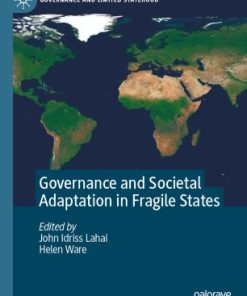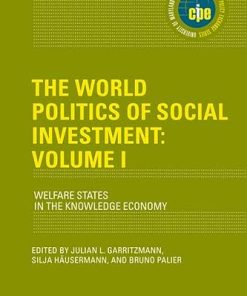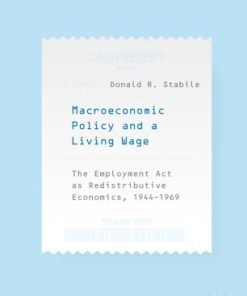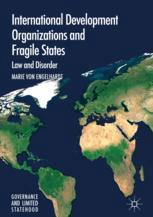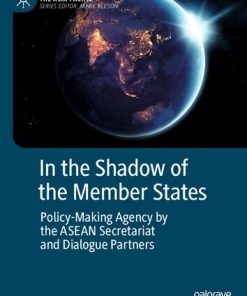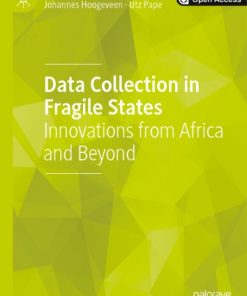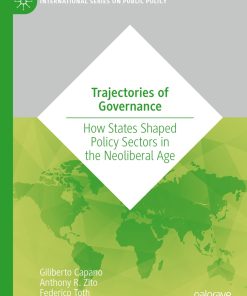(Ebook PDF) Macroeconomic Policy in Fragile States 1st edition by Ralph Chami, Raphael Espinoza, Peter Montiel ISBN 9780192594549 0192594540 full chapters
$50.00 Original price was: $50.00.$25.00Current price is: $25.00.
Macroeconomic Policy in Fragile States Ralph Chami Digital Instant Download
Author(s): Ralph Chami, Raphael Espinoza, Peter J. Montiel
ISBN(s): 9780198853091, 0198853092
File Details: PDF, 11.64 MB
Year: 2021
Language: English
SKU: EB-26454906
Category: Business & Economics
Tags: Peter J. Montiel, Ralph Chami, Raphael Espinoza
(Ebook PDF) Macroeconomic Policy in Fragile States 1st edition by Ralph Chami, Raphael Espinoza, Peter Montiel -Ebook PDF Instant Download/Delivery:9780192594549, 0192594540
Instant download Full Chapter of Macroeconomic Policy in Fragile States 1st edition after payment
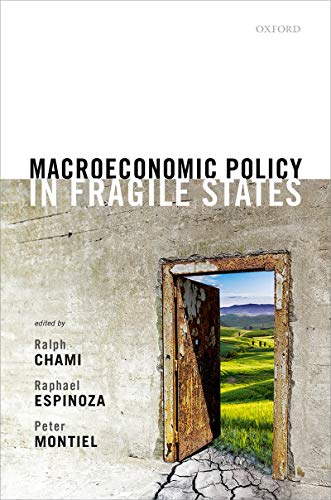
Product details:
ISBN 10:0192594540
ISBN 13:9780192594549
Author: Ralph Chami, Raphael A. Espinoza, Peter J. Montiel
Setting macroeconomic policy is especially difficult in fragile states. Political legitimacy concerns are heightened, raising issues such as who the policymakers are, what incentives they face, and how the process of policymaking is likely to work under limited legitimacy and high uncertainty both about the macroeconomic environment as well as policy effectiveness. In addition, fragility expands the range of policy objectives in ways that may constrain the attainment of standard macroeconomic objectives. Specifically, in the context of fragility policymakers also need to focus on measures to mitigate fragility itself – i.e., they need to address issues such as regional and ethnic economic disparities, youth unemployment, and food price inflation. Socio-political developments around the world have thus pushed policymakers to broaden their toolkit to improve the effectiveness of macroeconomic management in the face of these constraints. The chapters in Macroeconomic Policy in Fragile States address these issues, both by giving an analytical context from which policymakers can build to answer the questions they face in fragile situations as well as by providing lessons drawn from empirical analyses and case studies. The first section of the volume discusses the interactions between political economy considerations and macroeconomic policymaking. The second section covers the private sector environment in fragile states. The third section focuses on macroeconomic policy, especially fiscal policy, monetary policy, exchange rate policy, external flows, and aid effectiveness. The last section explains the role of the IMF in fragile states and concludes by presenting case studies from the Middle East and from Sub-Saharan Africa. The contributors to the volume are economists and political scientists from academia as well as policymakers from international organizations and from countries affected by fragility.
Table of Contents:
- 1. Macroeconomic Policy Issues in Fragile States: A Framework
- 1. What Is Fragility?
- 2. Measuring Fragility
- 3. Macroeconomic Characteristics of Fragile States
- 4. Macroeconomic Policy Challenges in Fragile States
- 5. A Framework to Understand Fragility
- 6. Policy Lessons: a Primer
- 7. Conclusions
- 2. Building Inclusive States: A Simple Framework
- 1. Introduction
- 2. The Narrow Corridor and the Red Queen
- 3. Paper Leviathans
- 4. Getting into the Corridor
- 5. Conclusions
- 3. Transition Programs: A Theory of the Scaffolding Needed to Build out of Fragility
- 1. Introduction
- 2. The Syndrome of Fragility
- 3. The Sinews of State Effectiveness
- 4. Fragile States and Knightian Uncertainty
- 5. Conclusion
- 4. Building Governance Capacity in Areas of Limited Statehood
- 1. Governance in Areas of Limited Statehood: Conceptual Clarifications
- 2. Explaining Effective Governance in Areas of Limited Statehood
- 3. Policy Recommendations: Governance-Building Rather than State-Building
- 5. The Role of Trust in Rebuilding Countries in Fragile and Conflict Situations
- 1. Introduction
- 2. Trust and Domestic Institutions in FCS Countries
- 3. Trust and International Institutions in Countries in Fragile and Conflict Situations
- 4. Conclusion
- Fragility Indices
- 6. The Private Sector in Fragile Situations
- 1. Introduction
- 2. The Private Sector and Its Role in Building Resilience
- 3. Entrepreneurs and Markets in Fragile Situations
- 4. Public Policies for Private Sector Resilience and Growth in Fragile Situations
- Measuring Fragility
- 7. The State of Finance in Fragile States
- 1. Introduction
- 2. Financial Depth and Inclusion: Individual Measures
- 3. Composite Measures of Financial Development
- 4. Fragile States Compared to their Structural Benchmarks
- 5. Growth Costs of Financial Underdevelopment in Fragile States
- 6. Conclusions and Recommendations
- 8. The Challenge of Macroeconomic Stabilization in Fragile States
- 1. Introduction
- 2. The Model
- 3. Internal and External Balance
- 4. Dynamics
- 5. Steady-State Comparative Statics
- 6. Fragility and Policymaking
- 7. Summary and Conclusions
- Demand for Liquidity
- Derivation of External Balance Condition
- Linearization of the Dynamic Equations Driving the State of the Economy
- 9. Fiscal Capacity and State Fragility
- 1. Introduction
- 2. Institutions, Norms, and Culture
- 3. Country Experiences
- 4. Policy Implications
- 5. Concluding Comments
- 10. Fiscal Policy in Fragile Situations: Flying in Fog with Limited Instrumentation
- 1. Introduction
- 2. Background: Connecting Fragility and Fiscal Policy
- 3. An Analytical Framework
- 4. Discussion: Explaining Variation in Performance of Fragile States in Fiscal Policy and Outcomes
- 5. Conclusions and Future Research
- 11. Building Fiscal Institutions in Fragile States: A Two-Step Approach
- 1. Introduction
- 2. Building Tax Capacity
- 3. Building Public Financial Management Capacity
- 4. Fiscal Conditionality in IMF Programs and Fragile States
- 5. Concluding Remarks
- 12. Establishing a New Currency and Central Bank in Fragile States
- 1. Introduction
- 2. Central Banks’ Law and Organizational Structure
- 13. Monetary and Exchange Rate Policy in Fragile States
- 1. Introduction: The Stabilization Challenge in Fragile States
- 2. Summary Evidence: Monetary and Exchange Rate Regimes in Fragile States
- 3. Descent into Fragility: Alternative Monetary and Exchange Rate Pathologies
- 4. Exiting, Recovery, and Relapse
- 5. Conclusions: Key Lessons
- 14. Exports, Exchange Regimes, and Fragility
- 1. Introduction
- 2. Exports and Growth
- 3. Political Fragility
- 4. Modeling Fragility, Exports, and Exchange Regimes
- 5. Conclusions
- 15. Do Financial Flows Make a Difference in Fragile States?
- 1. Introduction
- 2. What Is Special about Fragile Countries?
- 3. Is There a Relationship between Fragility and Financial Flows?
- 4. How Does Fragility Influence the Effects of Financial Flows on Growth and Jobs?
- 5. Interpretation and Conclusion
- Fragility and Financial Flows: Causality Analysis
- Robustness Check
- Specific Fragility Dimensions
- OECD Fragility Indicator
- Country Fragility Groupings
- 16. Aid Effectiveness in Fragile States
- 1. Introduction
- 2. Aid Effectiveness: A Brief Literature Review
- 3. Is Aid in Fragile States Different? Stylized Facts
- 4. Aid Effectiveness: Project-Level Analysis
- 5. Conclusions and Policy Discussion
- 17. Assessing the Role of the IMF in Fragile States
- 1. Introduction
- 2. Key Features of Fragile States
- 3. Overview of the IMF’s Engagement in Fragile States
- 4. Assessing the Impact of IMF Involvement in Fragile States
- 5. Obstacles to IMF Effectiveness
- 6. Conclusion
- 18. Tailoring IMF-Supported Programs to Fragile and Conflict-Affected States’ NeedsWhat Works?
- 1. Motivation
- 2. Background
- 3. Design of IMF Conditionality in FCS versus Non-FCS
- 4. Analysis of Program Success
- 5. Concluding Remarks
- 19. Macroeconomic Policy Challenges in Conflict and Post-Conflict Countries: Experience and Lessons from the Middle East
- 1. Introduction
- 2. Characteristics of Economic Fragility: The Role of Conflict
- 3. Economic Consequences of Conflict and Fragility
- 4. Addressing Macroeconomic Policy Challenges in Conflict and Fragile Countries: The Role of the IMF
- 5. Conclusion
- 20. Exiting Fragility: The Experience of Five Sub-Saharan African Countries
- 1. Introduction
- 2. Case Studies
- 3. Comparative Analysis
- 4. Inclusion
- 5. Stabilization Policies and Institutions
- 6. Outcomes
- 7. Concluding Comments
People also search:
what is macroeconomic policy
examples of macroeconomic policy
macroeconomic policy in fragile states pdf
fragile states imf
macroeconomic policy implications
Tags:
Ralph Chami,Raphael Espinoza,Peter Montiel,Macroeconomic Policy,Fragile States
You may also like…
Sale!
Politics & Philosophy - Government & Politics
Governance and Societal Adaptation in Fragile States 1st ed. Edition John Idriss Lahai
Sale!
Sale!
Politics & Philosophy - Politics
Sale!
Business & Economics
Sale!
Politics & Philosophy
Sale!
Fiction
Sale!
Sale!
Engineering - Engineering - General & Miscellaneous
Sale!
Politics & Philosophy - Government & Politics




